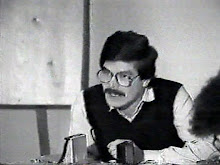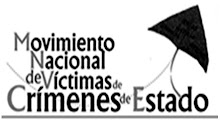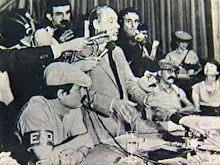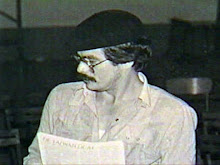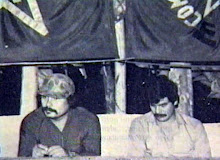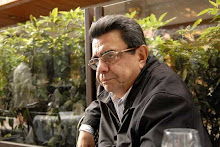 Mi última Rueda de Prensa. Oscar William Calvo en un registro de televisión, al medio día del 20 de noviembre de 1985 .
Mi última Rueda de Prensa. Oscar William Calvo en un registro de televisión, al medio día del 20 de noviembre de 1985 .Seis días después del asesinato en Barrancabermeja del antiguo guerrillero del ELN, Ricardo Lara Parada, vino el asesinato en Bogotá de Oscar William Calvo, representante del EPL en tregua en la Comisión de Paz. Al oscurecer, en la carrera trece con calle 42, Calvo recibió de "desconocidos", diecisiete tiros de ametralladora. Con él murieron dos jóvenes militantes del PCCML que lo acompañaban, y una señora que pasaba por el lugar. Los asesinos huyeron, y -como los de Lara Parada- no ha sido posible saber nada de ellos.
Con estos ultimos asesinatos el proceso de paz queda en estado preagónico. Ya venía grave a causa de la guerra abierta con el M-19 y la toma sangrienta del Palacio de Justicia con su respuesta militar, y el holocausto de los jueces lo había dejado peor aún. El EPL y las FARC se mantenían todavía en tregua, pero de manera bastante ambigua. Así, el 18 de noviembre, fuerzas del EPL combinadas con otras del M-19 se tomaron la población antioqueña de Urrao, y a continuación hicieron llegar a los medios de información un comunicado firmado conjuntamente, en el que llamaban a la acción "un avance en la conformación de un ejército único, como el propuesto en la reunión de la Coordinadora Cuerrillera celebrada a comienzos de junio" (en esta Coordinadora, además del M-19 y el EPL, figuran el ELN, el Ricardo Franco, el PRT, Patria Libre y el Quintín Lame). El mismo día de su asesinato, Oscar William Calvo había explicado en rueda de prensa que lo de Urrao era simplemente una "acción defensiva" destinada a romper un cerco militar, y no ponía en juego la tregua. Pero esa poco convincente ambiguedad quedó definitivamente zanjada con el comunicado sacado por el EPL-PCCML, a raíz de su muerte, en el que llama a sus militantes a "responder a la oleada represiva con el combate político y la lucha armada".
Tanto el propio EPL, como el M-19 y la Unión Patriótica (representante de las FARC, único grupo guerrillero que, con el pequeño ADO, sigue en tregua), acusan abiertamente de los dos asesinatos (Lara y Calvo) a los grupos paramilitares enemigos de la paz. Francisco Caraballo, secretario nacional del PCCML, habla de la "ofensiva fascista del régimen, acentuada de manera criminal en los últimos meses", y responsabiliza del crimen "al gobierno de Betancur a sus fuerzas militares y paramilitares". El M-19 le echa la culpa "al gobierno militarista de Betancur". Y la UP, en comunicado cuyos firmantes encabeza Braulio Herrera, dice que ambos crímenes, sumados a las bombas contra la UP y el Partido Comunista y "sobre todo a los operativos ofensivos contra los frentes de las FARC en tregua configuran toda una escalada militarista que busca a toda costa y a cualquier precio romper el proceso de paz y conducir al país a una confrontación sangrienta entre colombianos de inimaginables proporciones". En efecto: si los comunicados y las acciones de los grupos guerrilleros son ya inequívocos, también lo son los asesinatos y las bombas.
En cuanto a las Fuerzas Armadas, también sus prioridades son claras: el país está en guerra, y por eso retiraron cinco helicópteros de las operaciones de rescate de Armero para enviarlos en persecución de los asaltantes de Urrao. De la paz de Betancur no iba quedando sino la Comisión de Paz, que tras sus crisis sucesivas había sido finalmente reintegrada por el Presidente hace apenas un mes. Nació cojeando, sin representantes del Partido Liberal ni del Congreso, ni tampoco de los militares en retiro, que no aceptaron, como consecuencia del atentado del M-19 contra el Comandante en Jefe del Ejército. A raíz de la toma del Palacio de Justicia, cuando la Comisión no fue consultada, renuncio también el representante del Nuevo Liberalismo. Ahora acaba de ser asesinado Oscar William Calvo, quien representaba en ella al EPL, y al cerrar esta edición corría el rumor de la renuncia de Carlos Efrén Agudelo, representante del ADO, y del ex canciller Alfredo Vásquez Carrizosa. Queda, pues, apenas un muñón de Comisión de Paz. Y es difícil creer que sus escasos integrantes puedan, en las circunstancias actuales, discutir seriamente el tema que les ha confiado el presidente Betancur: el de si se prorroga o no la tregua con las FARC.
Da la impresión de que el proceso de paz, que nació en medio de los tiroteos de la toma de Yumbo por el M-19 y del asesinato de Carlos Toledo Plata, y que a lo largo de año y medio ha estado puntuada de combates y atentados, no va a poder aguantar muchos días más el mismo trato. Ni siquiera retóricamente.
Con estos ultimos asesinatos el proceso de paz queda en estado preagónico. Ya venía grave a causa de la guerra abierta con el M-19 y la toma sangrienta del Palacio de Justicia con su respuesta militar, y el holocausto de los jueces lo había dejado peor aún. El EPL y las FARC se mantenían todavía en tregua, pero de manera bastante ambigua. Así, el 18 de noviembre, fuerzas del EPL combinadas con otras del M-19 se tomaron la población antioqueña de Urrao, y a continuación hicieron llegar a los medios de información un comunicado firmado conjuntamente, en el que llamaban a la acción "un avance en la conformación de un ejército único, como el propuesto en la reunión de la Coordinadora Cuerrillera celebrada a comienzos de junio" (en esta Coordinadora, además del M-19 y el EPL, figuran el ELN, el Ricardo Franco, el PRT, Patria Libre y el Quintín Lame). El mismo día de su asesinato, Oscar William Calvo había explicado en rueda de prensa que lo de Urrao era simplemente una "acción defensiva" destinada a romper un cerco militar, y no ponía en juego la tregua. Pero esa poco convincente ambiguedad quedó definitivamente zanjada con el comunicado sacado por el EPL-PCCML, a raíz de su muerte, en el que llama a sus militantes a "responder a la oleada represiva con el combate político y la lucha armada".
Tanto el propio EPL, como el M-19 y la Unión Patriótica (representante de las FARC, único grupo guerrillero que, con el pequeño ADO, sigue en tregua), acusan abiertamente de los dos asesinatos (Lara y Calvo) a los grupos paramilitares enemigos de la paz. Francisco Caraballo, secretario nacional del PCCML, habla de la "ofensiva fascista del régimen, acentuada de manera criminal en los últimos meses", y responsabiliza del crimen "al gobierno de Betancur a sus fuerzas militares y paramilitares". El M-19 le echa la culpa "al gobierno militarista de Betancur". Y la UP, en comunicado cuyos firmantes encabeza Braulio Herrera, dice que ambos crímenes, sumados a las bombas contra la UP y el Partido Comunista y "sobre todo a los operativos ofensivos contra los frentes de las FARC en tregua configuran toda una escalada militarista que busca a toda costa y a cualquier precio romper el proceso de paz y conducir al país a una confrontación sangrienta entre colombianos de inimaginables proporciones". En efecto: si los comunicados y las acciones de los grupos guerrilleros son ya inequívocos, también lo son los asesinatos y las bombas.
En cuanto a las Fuerzas Armadas, también sus prioridades son claras: el país está en guerra, y por eso retiraron cinco helicópteros de las operaciones de rescate de Armero para enviarlos en persecución de los asaltantes de Urrao. De la paz de Betancur no iba quedando sino la Comisión de Paz, que tras sus crisis sucesivas había sido finalmente reintegrada por el Presidente hace apenas un mes. Nació cojeando, sin representantes del Partido Liberal ni del Congreso, ni tampoco de los militares en retiro, que no aceptaron, como consecuencia del atentado del M-19 contra el Comandante en Jefe del Ejército. A raíz de la toma del Palacio de Justicia, cuando la Comisión no fue consultada, renuncio también el representante del Nuevo Liberalismo. Ahora acaba de ser asesinado Oscar William Calvo, quien representaba en ella al EPL, y al cerrar esta edición corría el rumor de la renuncia de Carlos Efrén Agudelo, representante del ADO, y del ex canciller Alfredo Vásquez Carrizosa. Queda, pues, apenas un muñón de Comisión de Paz. Y es difícil creer que sus escasos integrantes puedan, en las circunstancias actuales, discutir seriamente el tema que les ha confiado el presidente Betancur: el de si se prorroga o no la tregua con las FARC.
Da la impresión de que el proceso de paz, que nació en medio de los tiroteos de la toma de Yumbo por el M-19 y del asesinato de Carlos Toledo Plata, y que a lo largo de año y medio ha estado puntuada de combates y atentados, no va a poder aguantar muchos días más el mismo trato. Ni siquiera retóricamente.



